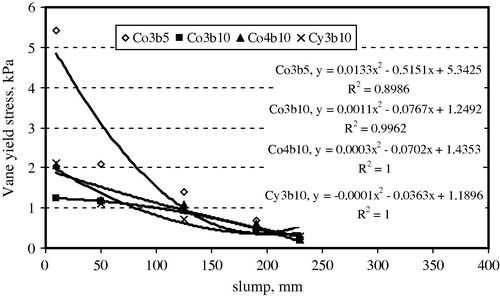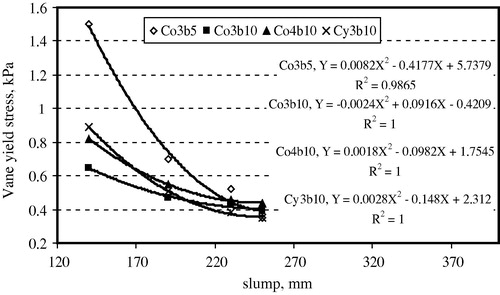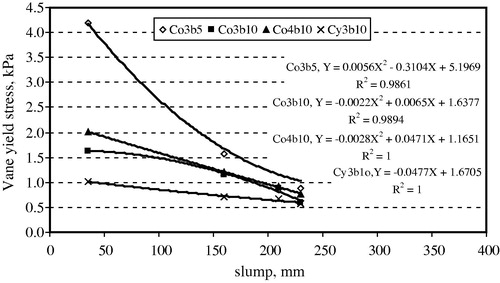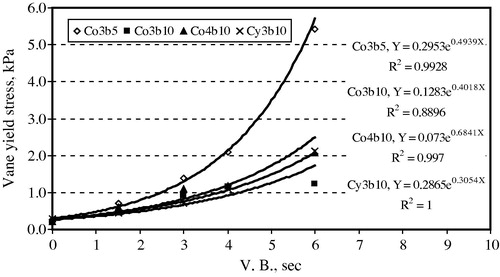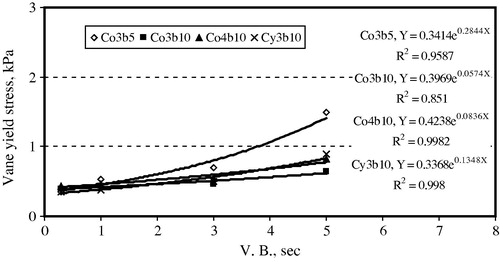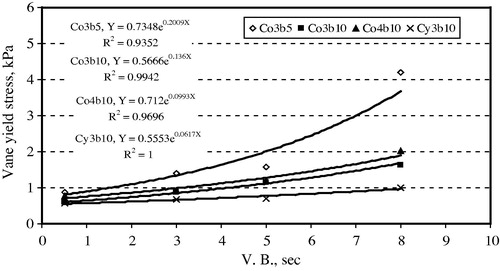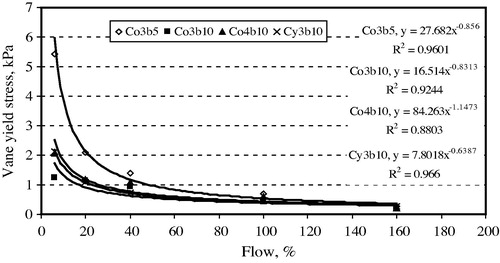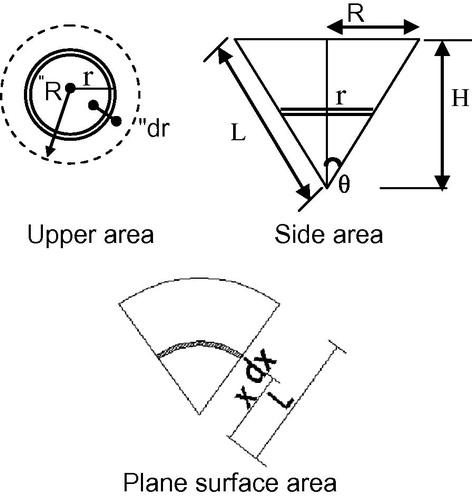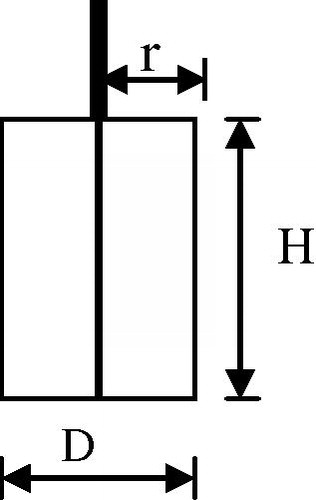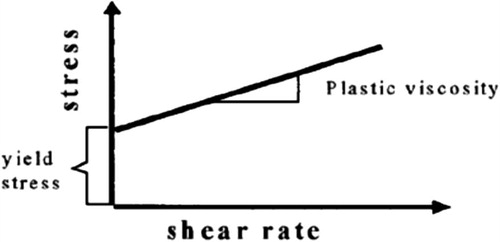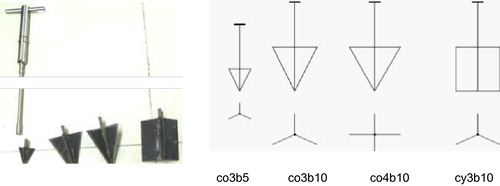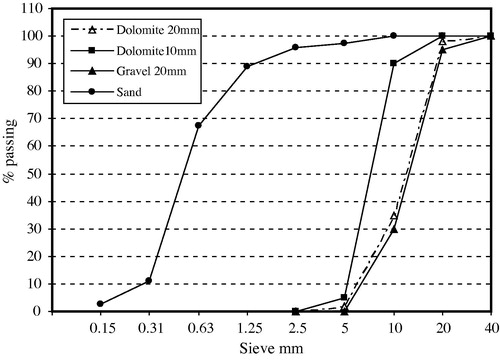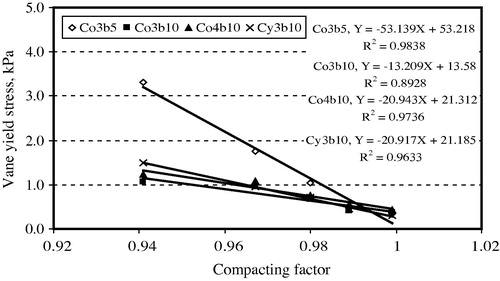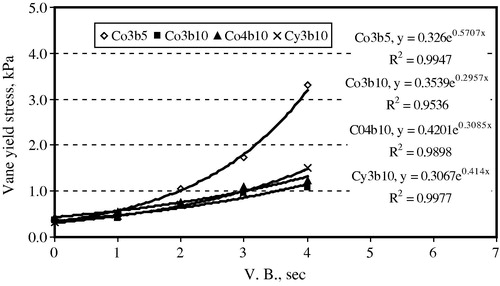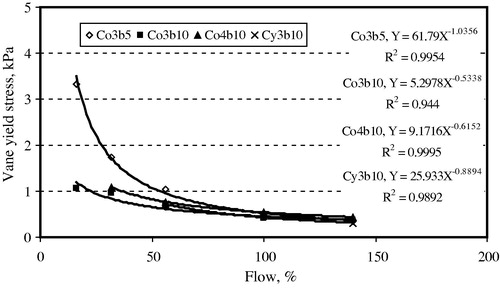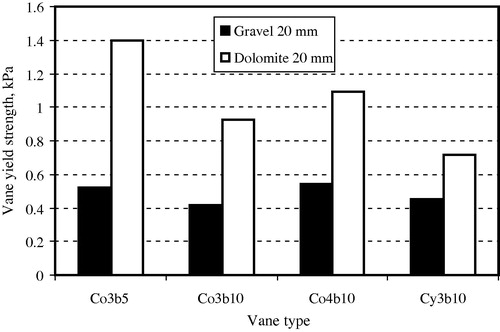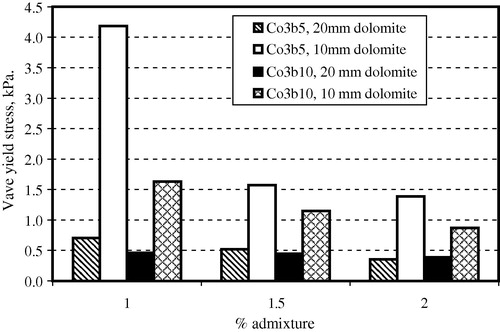 ?Mathematical formulae have been encoded as MathML and are displayed in this HTML version using MathJax in order to improve their display. Uncheck the box to turn MathJax off. This feature requires Javascript. Click on a formula to zoom.
?Mathematical formulae have been encoded as MathML and are displayed in this HTML version using MathJax in order to improve their display. Uncheck the box to turn MathJax off. This feature requires Javascript. Click on a formula to zoom.Abstract
An experimental investigation has been performed to study the efficiency of using modified geotechnical Vane shear test to evaluate the fresh properties of concrete. Different concrete mixes with different coarse aggregates (both type and size) were conducted. Moreover different shapes and sizes of Vane probes were investigated. Also the influence of using enhancing workability admixtures was studied. The results of the shear Vane test were statistically analyzed and compared with those for standard tests. The results reveal that the Vane shear test with modified blades can be simply executed to measure workability of concrete anywhere with a good efficiency. Useful equations with good correlation coefficients are established between the well known standard tests include compacting factor, slump, VeBe and flow tests and the Vane yield method. Size effect phenomenon related to Vane size is recorded for the Vane yield stress results. The results of the Vane yield stress could clearly distinguish between not only mixes made up of different aggregate types but also the aggregate maximum nominal size. The results of the Vane shear test are clearly affected by using enhancing workability admixtures and its dosage. A direct proportion between Vane yield stress results and the companion compacting factors test values is strongly noticed which introduces the Vane test method as a simple instrument that could be simply adapted anywhere to measure the workability of fresh concrete instead of compacting factor that is a laboratory apparatus.
Introduction
As soon as concrete is completely mixed it is called fresh concrete. It becomes green after initial setting up to being able to resist stresses. From that moment, the concrete is termed as hardened up to its terminal life. For each stage of concrete, there are many interested properties for all partners of concrete industry including researchers and Engineers. Properties of fresh concrete stage are of great interest for construction industry since concrete is usually put into place in its plastic form. As well as, ease of placement, consolidation, durability and strength strongly depend on the flow properties. Consistency and workability are two wide spread terms usually used to describe the flow properties of fresh concrete.
Fig. 6 Relationship between Vane yield stress and compacting factor for group 3 (dolomite 20 mm, w/c = 0.47).
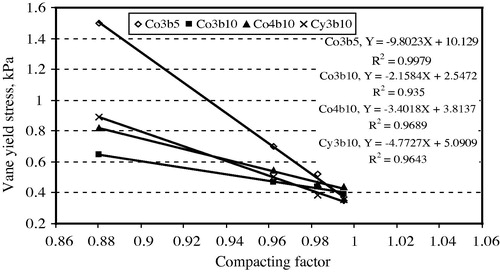
Fig. 7 Relationship between Vane yield stress and compacting factor for group 4 (dolomite 10 mm, w/c = 0.4).
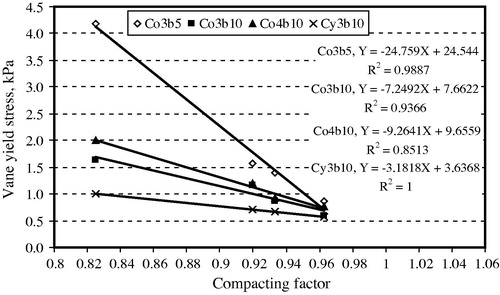
Fig. 18 Relationship between Vane yield stress and flow test for group 3 (dolomite 20 mm, w/c = 0.47).
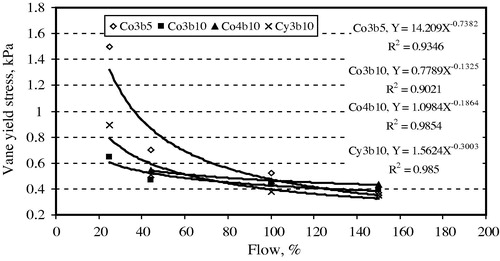
Fig. 19 Relationship between Vane yield stress and flow test for group 4 (dolomite 10 mm, w/c = 0.4).
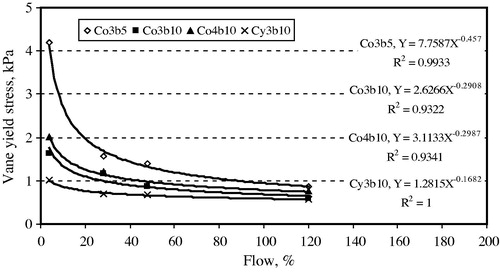
Table 3 Test results for group 2, dolomite (20 mm).
Table 4 Test results for group 3, dolomite (20 mm) (w/c = 0.47).
The authors of Ref. [Citation1] mention the following three terms while referring to concrete rheology: workability, consistency and plasticity. The definitions given are:
| • | “Workability is a measure of how easy or difficult it is to place, consolidate, and finish concrete” | ||||
| • | “Consistency is the ability of freshly mixed concrete to flow” | ||||
| • | “Plasticity determines concrete’s ease of molding”. | ||||
The concrete workability terminology was summarized very clearly by classifying it into three classes: qualitative, quantitative empirical and quantitative fundamental. The following items fall in the three classes [Citation2].
| • | Class I: qualitative-Workability, flowability, compactibility, stability, finishability, pumpability, consistency, etc. To be used only in a general descriptive way without any attempt to quantify. | ||||
| • | Class II: quantitative empirical-Slump, compacting factor, Ve-be, etc. To be used as a simple quantitative statement of behavior in a particular set of circumstances. | ||||
| • | Class III: quantitative fundamental-Viscosity, yield stress, etc. To be used in conformity with the British Standard [Citation3]. | ||||
An overview of the flow properties of a fluid or a suspension, followed by a critical review of the most commonly used concrete rheology tests. Particular attention is given to tests that could be used for high performance concrete HPC. Tentative definitions of terms such as workability, consistency, and rheological parameters are provided [Citation4]. Correlating slump, slump flow, VeBe and flow tests to rheological parameters of high-performance concrete was conducted [Citation5].
Numerous experimental tests have been established and have become as standard for measuring consistency. Test methods for flow properties of concrete can be divided into two groups in regard whether the output of the experiments gives one or two parameters. These groups include, one factor test and two factors test [Citation4]. One factor tests are the tests used to measure only one rheological value or factor. These tests include, slump, Kelly ball, k slump, VeBe, LCL apparatus, vibration testing, flow cone, turning tube viscometer, filling ability and Oriment apparatus. Two factor tests are tests can measure indirectly both the viscosity and yield stress. The most common tests for this brand include, Tattersal two-point test, Bertta apparatus, the BTRHEOM Rheometer and modified slump cone test. The description of the 61 test methods for measuring concrete workability was conducted [Citation6]. Based on the successes and failures of past test methods and the current needs of the concrete industry, requirements for new test methods are developed.
Among all, the slump test is considered the widest spread standard test to be used at both field and laboratory to measure the flow properties of fresh concrete. This because of its simplicity as well as it is considered as a useful quality control tool since it can help detect changes in the composition of concrete delivered, e.g., changes in the amount of mixing water. But the draw back of this test is that it cannot clearly distinguish between the flow properties of stiff concrete mixes and floppy ones.
Author of Ref. [Citation2] designed the first and most widely known instrument (Tattersall two-point rheometer) for measuring the flow properties of concrete and gave the following equation:(1)
(1) Where: τ = torque, G = constant obtained by calibration with Newtonian fluids, K = constant obtained by calibration with non-Newtonian fluids, N = speed of the impeller, τ0 = yield stress, η = viscosity
Therefore, τ0 = g/(G/K) and n = h/G, where g and h are the two values measured.
Because concrete flows as a liquid, Eq. (Equation2(2)
(2) ) is applicable. The liquid that obeys that equation is called Newtonian fluid [Citation7]. Many other equations are commonly used for concrete. and Eq. (Equation3
(3)
(3) ) show the Bingham’s equation for fluid [Citation2].
(2)
(2)
(3)
(3) Where: τ = shear stress (Pa), η = viscosity (Pa·s), γ = shear strain rates (s−1) and τ0 = yield stress (Pa)
The Vane test is a tool that has been used in rheology studies of material in different fields. This method has been highly developed in geotechnical field and it is used to determine a parameter defined as “strength of the soil”. In recent years, with the development of instrumentation techniques, geared especially towards rheometry. The shear Vane test was introduced as a simple efficient method to measure the yield stress among other properties of non-Newtonian fluids. The authors of Ref. [Citation8] used this technique to study rheological properties in freshly applied mortar. That method managed them to define clear conditions in the applying of the mortar.
An evaluation of the workability of freshly mixed Portland cement concrete while it is still in the mixing truck by determining fundamental rheological parameters (plastic viscosity and yield stress) was studied [Citation9].
In essence, the field of concrete technology and industry still needs simple and reliable methods that enable all partners of concrete industry to simply evaluate the flow properties of fresh concrete. Few numbers of studies dealing with the implementation of the geotechnical Vane shear test to measure the flow properties of freshly cement based mixes are available. The available studies do not cover using of different blade shapes, application to different aggregate types, influence of maximum nominal size, effect of Vane blade size as well as the influence of using enhancing workability admixtures. So this study is an experimental attempt to clearly over view the above issues.
Research significant and objectives
Properties of fresh concrete are of great interest for construction industry due to its major influence in all short and long term properties. Developing new methods as well as modifying exist ones to be more reliable and efficient are still strongly needed. This paper introduces the applications of the geotechnical Vane shear test anywhere to measure the flow properties of freshly mixed concrete not only at laboratory but also at fields. The main goals of this investigation are to;
| – | Study the efficiency of the geotechnical shear Vane method to evaluate the fresh properties of concrete, | ||||
| – | Investigate the influence of both shape and size of Vane probe’s on the flow properties of freshly mixed concrete, | ||||
| – | Evaluate the influence of both aggregate type and aggregate maximum nominal size on the Vane yield stress results and, | ||||
| – | Explore the influence of using workability enhancing admixtures on the Vane yield stress results. | ||||
Finally, a comparison between the Vane yield stress results obtained with those of the well-known standard workability and consistency test methods are made through a statistical study.
Experimental work
An extensive experimental program is designed to study the efficiency of using geotechnical Vane shear test to assess and measure the flow properties of freshly mixed concrete. The Vane shear yield stress test were conducted in a companion with the well-know workability and consistency standard test methods. The commonly test methods conducted in parallel with the Vane test include, slump test, VeBe test, flow test and compacting factor test. The main parameters of this investigation comprise;
| – | Type of coarse aggregate (gravel and dolomite). | ||||
| – | Maximum nominal size of coarse aggregates (20 mm and 10 mm). | ||||
| – | Different levels of workability and consistency that are governed through varying water to cement ratio (0.4–0.7) without admixtures. | ||||
| – | Using of superplasticizer admixtures (HRWR) (0.5%, 1%, 1.5% and 2% by cement weight) which were used to control both the workability and consistency degrees with fixed water cement ratio. | ||||
| – | Vane probe with different dimensions (D × H (diameter × height)) and shapes as depicted in (conical with three blades (co3b5 and co3b10) and four blades (co4b10) and cylindrical with three blades (cy3b10)). The blades of the Vane probe were manufactured from 2 mm steel plates to enable the use of one torque—meter to capture shear stresses of the fresh concrete after mixing. presents not only the schedule of experimental work but also include the proportions of concrete mixes and tests. | ||||
Table 1 Schedule of experimental work.
Materials
All materials used in this work are available in Egypt local market. The cement used in all mixes is type I Portland cement-grade 42.5 N confirmed requirements of the Egyptian Standard Specifications ESS requirements (4756-1/2007). Natural siliceous sand with finesses modulus of 2.37 was used. Two types of coarse aggregates were used namely, natural gravel and crushed dolomite. The grading curves are shown in . A Well graded rather rounded in shape with a maximum size of 20 mm gravel was obtained from Suez quarries. Moreover, two sizes of dolomite from Attaka quarries with 20 mm and 10 mm maximum nominal size were employed. The dolomite particle has a granular porous texture, rough surface and irregular. Fine and coarse aggregates confirmed the ESS requirements (1109–2002). Tap water was used for all mixes. A high range water reducing admixtures (HRWR) with trade name Sikament-163M. It complies with ASTM C-494 Type A&F and B.S. 5075 Part 3 with specific gravity 1.2 and it was added within the range recommended by the manufacturer.
Methodology
Eighteen mixes divided into four groups as shown in were prepared and tested. The concrete mixes were mixed in a portable concrete mixer with a maximum capacity of 100 L. The water (or water and admixtures when used) and cementitious materials are mixed for a half minute to ensure the uniformity of the constituents. Sand is simultaneously charged into the mixer and the mixing process was continued for a half minute and then coarse aggregate was added. After that, the total content was mixed for a period of two minutes. After mixing, the test method concept involves basically inserting the different Vane probe in the concrete rested in the mixer to be tested. Subsequently, the Vane is manually turned according to a slowly constant strain rate (constant angular velocity). While torque moment is applied, a shear stress is generated in the stressed area which is being conical or cylindrical one according to the Vane shear blade shape. When the torque moment produces a shear stress equal to the yield capacity of the tested concrete mix, the sheared surface starts to rotate. At that moment and according to the maximum torque measured, the Vane yield stress is calculated. In section: Derivation of the Vane yield stress equation explains the method and calculations procedure of the Vane yield stress. After conducting the Vane shear test, the common tests include slump test according to the procedure described in Egyptian Code ECP 203:2009, ASTM C143 and BS 1881 part 102 BS 5075 standards, VeBe test according to BS 1881 EN 12350-3, flow test according to BS EN 12350-5 and compacting factor test have been conducted according to ECP 203:2009 and BS 1881 part 103 BS 5073.
It is recommended that the Vane’s rotation speed should be less than 10 rpm so as to avoid any influence on viscosity resistance and the instrument’s inertia in maximum torque determination. A recommended velocity of 0.1 rpm (36°/min) was proposed in many studies. In some developed preliminary studies it was concluded that angular velocities between 30° and 90°/min, the measured maximum shear values did not undergo major alterations [Citation8].
Derivation of the Vane yield stress equation
In this study the Vane is turned slowly according to a constant strain rate (constant angular velocity). The sheared concrete yields when the applied torque reaches the maximum value and so causes shearing of the material in the area around the Vane. The conical Vane probe is tried due to the simplicity of its immersion into fresh concrete. The maximum torque obtained in the experiment of cone Vane probe τcone can be defined as the algebraic sum of the moment exerted on the surface area τ1 and on the Vane upper area τ2 as depict below and calculated according to Eq. (Equation4(4)
(4) ) derived in this paper as following:
Where: τcone: the torque, σ: the shear stress, r: radius of the sheared cone
In terms of shear stresses the torque is defined as(4)
(4)
In case of cylindrical Vane probe and as given in Ref. [Citation8], the maximum torque τcy (Eq. (Equation5(5)
(5) )) obtained by the algebraic sum of moment exerted by the surface area τ1 and by the Vane upper and lower areas τ2 by the following:
(5)
(5)
Results and discussion
The experimental investigation was conducted to study the ability and the factors influencing the use of the well known geotechnical Vane shear test to measure and asses the flow properties of fresh concrete mixes. Four main groups containing 18 concrete mixes were investigated. The parameters studied covered the influence of type and size of coarse aggregate, using of enhancing workability admixtures as well as the size and shape of the Vane probe used. The following paragraphs explain the influence of each parameter. present the results of all concrete groups. Eqs. (Equation4(4)
(4) ) and (Equation5
(5)
(5) ) were used to calculate the Vane yield stress for conical and cylindrical Vane probe, respectively.
Table 2 Test results for group 1, gravel (20 mm).
Table 5 Test results for group 4, dolomite (10 mm) (w/c = 0.4).
Results and analysis of Vane yield stress and compacting factor tests
Results of both of the Vane yield stress and the compacting factor are given in – for all mixes. – show the relationship between Vane yield stress and compacting factor results. It can be noticed that linear regression equations with high correlation coefficients could be established for all investigated mixes (R2 = 0.8513−1). The proposed regression equations take the following form Eq. (Equation6(6)
(6) ).
Vane yield stress (kPa) = −constant (compacting factor) + constant or,(6)
(6) where, Y = Vane yield stress (kPa), X = compacting factor and A is a constant
Considering the values of the constant (A), it can be noticed the following;
For Vane of 50 mm size (co3b5), the constant values (A) approach 53.2, 27.1, 10 and 24.65 for groups 1, 2, 3 and 4, respectively. And for Vane of 100 mm size (co3b10), those values approach 13.4, 5.7, 2.35 and 7.46, respectively. The corresponding values for Vane of 100 mm (co4b10) approach 21.1, 11.1, 3.6 and 9.46 for the same groups, respectively. Finally and for Vane of 100 mm (cy3b10), the constant values (A) approach 21, 9.7, 4.9 and 3.4, respectively. The higher the value of the constant (A) means more degradation of the Vane yield stress against the values of the compacting factor and vice versa is correct. It could also be noticed that when compacting factor approach unity the Vane yield stress approach the value of the constant (A) while it approaches zero when the compacting value reaches unity. The values of this constant are greater for mixes containing gravel compared with those mixes containing dolomite of the same maximum nominal size. While for mixes containing dolomite of 20 mm maximum nominal size, the values of the constant tend to be smaller with using enhancing workability admixtures compared to the corresponding mixes without admixtures. Also, considering mixes containing 10 mm dolomite maximum size, the constant values tend to be greater compared with the corresponding mix with higher aggregate size. In general, the direct proportion between Vane yield stress results and compacting factors introduces an instrument could be simply adapted anywhere to measure the workability of fresh concrete instead of compacting factor that is a laboratory apparatus. The coefficient (A) joins the relationship between the Vane results and the compacting factor values. The values of that coefficient depend on the type of coarse aggregate, maximum nominal size, size and shape of the Vane used and using admixtures.
Results and analysis of Vane yield stress and slump tests
Vane yield stress and slump values are given in Tables – for all mixes. – present the relationship between the Vane yield stress and the slump values. Second degree regression equations are plotted for Vane yield stress against slump values with higher regression coefficients (R2 = 0.898−1). The proposed regression equations take the following form Eq. (Equation7(7)
(7) );
(7)
(7) Where, Y = Vane yield stress (kPa), X = slump (mm) and A1, A2 & A3 are constants
That relation has the same trend for all investigated mixes including all sizes and shapes of the investigated Vane instrument. Moreover, it can be noticed that with the increase of the slump values a noticeable decrease in the measured values of the Vane yield stress are recorded. Results of Vane instrument (co3b5) show a more sensitivity between slump values and the Vane yield stress. Whereas, other Vane instruments (co3b10, co4b10 & cy3b10) show lower sensitivity rate between slump values and the Vane yield stress.
Results and analysis of Vane yield stress and VeBe tests
– show the results of the Vane yield test results versus VeBe times for all mixes. Exponential regression equations are constructed between the Vane yield and the VeBe time values with regression coefficients (R2 = 0.89−1). The proposed regression equations take the following form Eq. (Equation8(8)
(8) );
(8)
(8) Where, Y = Vane yield stress (kPa), X = VeBe time (s) and B & C are constants
Results of Vane instrument (co3b5) show a rapid change between VeBe time values and the Vane yield stress especially for mixes without enhancing workability admixtures. Whereas, that trend is steeper for mix containing dolomite without admixtures. For mixes containing 10 mm dolomite, lower workability level was recorded compared to that of the corresponding dolomite mix of 20 mm maximum nominal size through the high values of the Vane yield stress. Whereas, other Vane instruments (co3b10, co4b10 & cy3b10) show the same trend but with lower rate of change between VeBe time values and the Vane yield stress.
Results and analysis of Vane yield stress and flow tests
– show the results of the Vane yield test versus% flow for all mixes. Power regression equations are constructed between the Vane yield and the% flow values with regression coefficients (R2 = 0.8803−1). The proposed regression equations take the following form Eq. (Equation9(9)
(9) );
(9)
(9) Where, Y = Vane yield stress (kPa), X = % flow and D & E are constants
Results of Vane instrument (co3b5) show a rapid change between% flow values and the Vane yield stress especially for mixes without enhancing workability admixtures.
For mixes containing 10 mm dolomite lower workability level compared to that of the corresponding dolomite mix of 20 mm maximum nominal size was recorded that can be understood from the results of the Vane yield stress. Whereas, other Vane instruments (co3b10, co4b10 & cy3b10), show the same trend but with lower rate of change between% flow values and the Vane yield stress.
Effect of Vane size on Vane yield stress
The influence of Vane size on the results of the Vane yield stress is presented in . For concrete mix containing 20 mm gravel and at relatively low w/c, the Vane yield stress using (co3b5) approaches 3.1 times that recorded for (co3b10). The ratio between the recorded values using (co3b5) to these recorded by (co3b10) are reduced with the fluidity of the concrete. This ratio approaches unity at w/c = 0.577.
Table 6 Effect of Vane probe size for all groups.
For concrete mix containing 20 mm dolomite and at relatively low w/c, the Vane yield stress using (co3b5) is greater compared to those measured using (co3b10). The ratio between the recorded values using (co3b5) to these recorded by (co3b10) are reduced with the fluidity of the concrete. This ratio approaches 1.333 at w/c = 0.675.
For concrete mix containing 20 mm dolomite with enhancing workability admixture and at relatively low w/c, the Vane yield stress using (co3b5) is greater compared to those measured using (co3b10). The ratio between the recorded values using (co3b5) to these recorded by (co3b10) are reduced with the fluidity of the concrete. This ratio approaches 0.89 at 2% admixture.
For concrete mix containing 10 mm dolomite with enhancing workability admixture and at relatively low w/c, the Vane yield stress using (co3b5) is greater compared to those measured using (co3b10). The ratio between the recorded values using (co3b5) to these recorded by (co3b10) are reduced with the fluidity of the concrete. This ratio approaches 1.481 at 2.5% admixture.
Based on the investigation results, a size effect is recorded. Generally for all the conducted concrete mixes, Vane yield stress measured using a relatively small Vane instrument is higher compared to those got using Vane instrument with bigger dimensions. So the bigger the size of the Vane blade the lower the values of the Vane yield stress measured and vice versa is correct.
Effect of coarse aggregate type on the Vane yield stress
The influence of the coarse aggregate type on the values of the Vane yield stress is plotted in . The results explain the influence of using either gravel or dolomite of the same maximum nominal size. As it is clear and for the four different Vane instruments conducted in this study, the values obtained for gravel mixes are smaller compared to the values obtained for the corresponding dolomite mixes. The relative values (for gravel mixes to dolomite ones) for the implemented Vane instruments are 0.375, 0.447, 0.5 and 0.632 for Vane probe co3b5, co3b10, co4b10 and cy3b10, respectively. That is agree well with the fundamental that the mixes containing dolomite as a coarse aggregate give a relatively stiffer concrete mixes compared to those containing gravel as a coarse aggregate type. Generally, the Vane yield stress values are relatively higher for mixes cast with dolomite compared to those for the corresponding mixes made up of gravel as a coarse aggregate type.
Effect of coarse aggregate maximum nominal size on Vane yield stress
Effect of coarse aggregate maximum nominal size on the results of Vane yield stress is presented in . This figure covers the influence of both the maximum nominal size for the dolomite used and the size of the implemented Vane instrument. Considering (co3b5) as instrument and with the same admixture content, the results of the Vane yield stress appeared to be higher for mixes containing 10 mm maximum nominal size compared to those for 20 mm maximum nominal size. The values for 10 mm compared with 20 mm maximum nominal sizes are 6.0, 3.0 and 4.0 for 1%, 1.5% and 2% admixtures content, respectively. Considering (co3b10) as instrument, the results of the Vane yield stress appeared to be higher for mixes containing 10 mm maximum nominal size compared to those for 20 mm maximum nominal size. The values for 10 mm to those for 20 mm maximum nominal sizes are 3.5, 3.58 and 2.22 for 1%, 1.5% and 2% admixtures content, respectively. It can be concluded that for the same admixture content, using smaller values of the maximum nominal sizes make the mix a relatively stiffer which can be observed from the higher values for the Vane yield stress compared to those values obtained for mixes containing dolomite of 20 mm maximum nominal size.
Conclusions
Based on the results of this investigation the following conclusions could be drawn;
| – | The geotechnical Vane shear device with modified Vane blades can be successfully adapted at laboratory or field to measure the flow properties of freshly mixed concrete with different workability levels. | ||||
| – | The direct proportionality between Vane yield stress results and compacting factors introduces the Vane test method as a simple instrument that could be simply adapted anywhere to measure the workability of fresh concrete instead of compacting factor that is a laboratory apparatus. | ||||
| – | Size effect phenomenon is recorded for the Vane yield stress results. Generally for the conducted concrete mixes, Vane yield stress measured using a relatively small Vane instrument is higher compared to those got using Vane instrument with bigger dimensions. So the bigger the size of the Vane blade the lower the values of the Vane yield stress measured and vice versa is correct. | ||||
| – | For the same admixture content, using smaller values of the maximum nominal sizes make the mix a relatively stiffer which can be observed from the higher values for the Vane yield stress compared to those values obtained for mixes containing dolomite of higher maximum nominal size. | ||||
| – | The results of the Vane yield stress are clearly distinguish between mixes made up of gravel and those cast with dolomite which agrees well with the results of the traditional standard test methods. | ||||
| – | With good correlation coefficients useful relations are established between Vane yield stress and properties of fresh concrete. The proposed equations take the forms given in Eqs. (Equation6 | ||||
Notes
Peer review under responsibility of Housing and Building National Research Center.
References
- S.H.KosmatkaW.C.PanareseDesign and Control of Concrete Mixtures1994PCA
- G.H.TattersallThe Workability of Concrete1976A viewpoint Publication, PCA
- British Standard Institution BS 5168: Glossary of Standard Rheological Terms, 1975.
- C.F.FerrarisMeasurement of the rheological properties of high performance concrete: state of the art reportJournal of Research of the National Institute of Standards and Technology10451999461478
- E.P. Koehler, D.W. Fowler. Summary of Concrete Workability Test Methods, International Center for Aggregates Research, Report No. ICAR 105–1, The University of Texas, Austin, 2003.
- A.I.LaskarCorrelating slump, slump flow, VeBe and flow tests to rheological parameters of high-performance concreteMaterials Research India12120097581
- P.BartosFresh Concrete: Properties and Tests1992Elsevier
- E.BauerJ.G.G.de SousaE.A.GuimaraesF.G.S.SilvaStudy of the laboratory Vane test on mortarsBuilding and Environment4220078692
- S.AmzianeC.F.FerrarisE.P.KoehlerMeasurement of workability of fresh concrete using a mixing truckJournal of Research of the National Institute of Standards and Technology11012005

